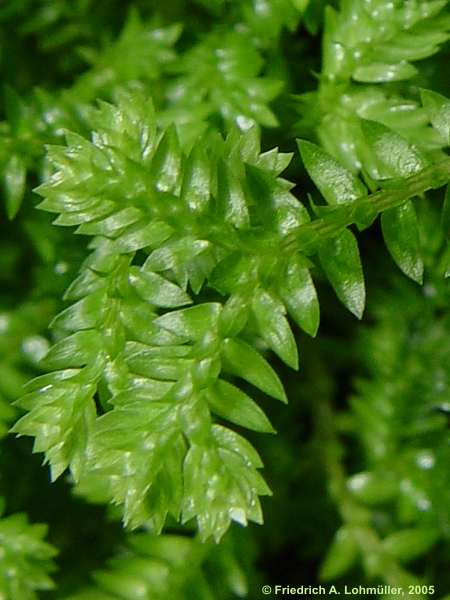(Kunze) A.Braun, Selaginellaceae

|

|

|

|
|
(Kunze) A.Braun, Selaginellaceae |
|
Present on Pacific Islands? yes
Primarily a threat at high elevations? no
Other Latin names: Lycopodium kraussianum Kunze
Common name(s): [more details]
|
English: Krauss' spike-moss, mat spike-moss, selaginella, small club moss, spreading club-moss, trailing spike-moss |
|
Hawaiian: lepelepe a moa |
Habit: fern
Description: "Plants terrestrial, forming diffuse mats. Stems long-creeping, branched, branches 3-forked, flat, articulate, glabrous. Rhizophores borne on upper side of stems throughout stem length, 1-3 mm in diameter. Leaves delicate, papery. Lateral leaves nearly perpendicular to stem, well spaced, green, lanceolate, 2.5-3.6 x 0.8-1.2 mm; base rounded; margins slightly transparent to green, dentate; apex acute. Median leaves lanceolate to linear-lanceolate, 2-2.7 x 0.6-0.8 mm; base with small outer auricle; margins slightly transparent to green, dentate; apex acuminate. Strobili solitary, 0.2-2.5 cm, with only 1 megasporangium, megasporangium basal; sporophylls keeled, dentate, strongly tapering toward apex, base glabrous, margins denticulate, apex acuminate; megasporophylls larger than microsporophylls, in groups of 4, 2 like vegetative leaves, 2 like sporophylls, of the latter 1 large, lanceolate-elliptic, 1 smaller, falcate-lanceolate; microsporophylls lanceolate to narrowly ovate-lanceolate" (Flora of North America online).
"Horizontal rhizomes long-creeping, 4-5 mm wide including the very distant lateral leaves. Erect stems 1.5-6 cm long, pseudodichotomously (appearing somewhat pinnately) branched. Branchlets ca. 3.5-4 mm wide including the rather closely spaced lateral leaves. Lateral leaves elliptic-lanceolate, 2.5-3 mm long, 0.8-1 mm wide (ca. 1/4 smaller on the branchlets), minutely and evenly ciliolate. Cones tetragonal, 2-12 mm long, 1 mm wide" (Lettinger, 1985; p. 69).
Habitat/ecology: Terrestrial on riverbanks, along lake margins, and in well watered lawns" (Lettinger, 1985; p. 69). Cultivated as a decorative plant. In Hawai‘i, "it grows in lawns, edges of fields, and along trails and roadsides in wet areas" (Wilson, 1996).
Propagation: Spores and stem fragments.
Native range: South Africa.
Presence:
| Pacific | |||
|
Country/Terr./St. & Island group |
Location |
Cited status &
Cited as invasive & Cited as cultivated & Cited as aboriginal introduction? |
Reference &
Comments |
|
Australia (Pacific offshore islands)
Norfolk Islands |
Norfolk Island |
introduced
invasive cultivated |
Orchard, Anthony E., ed. (1994) (p. 13)
"A garden escape, persisting as a weed in a few places". Voucher cited: W.R. Sykes NI 658(CHR) |
|
State of Hawaii
Hawaiian Islands |
Hawai‘i (Big) Island | Wilson, K. A. (1996) | |
|
State of Hawaii
Hawaiian Islands |
Hawai‘i (Big) Island |
introduced
invasive cultivated |
Staples, George W./Herbst, Derral R. (2005) (p. 53)
Escape from cultivation. |
|
State of Hawaii
Hawaiian Islands |
Maui Island | Wilson, K. A. (1996) | |
|
State of Hawaii
Hawaiian Islands |
Maui Island |
introduced
invasive |
Wagner, W. L./Herbst, D. R./Lorence, D. H. (2013) |
|
State of Hawaii
Hawaiian Islands |
O‘ahu Island | Wilson, K. A. (1996) | |
|
State of Hawaii
Hawaiian Islands |
O‘ahu Island |
introduced
invasive cultivated |
Staples, George W./Herbst, Derral R. (2005) (p. 53)
Escape from cultivation. |
| Pacific Rim | |||
|
Country/Terr./St. & Island group |
Location |
Cited status &
Cited as invasive & Cited as cultivated & Cited as aboriginal introduction? |
Reference &
Comments |
|
Australia
Australia (continental) |
New South Wales |
introduced
invasive cultivated |
Australian Biological Resources Study (2013) |
|
China
China |
Hong Kong |
introduced
cultivated |
Wu, Te-lin (2001) (p. 8) |
|
New Zealand
New Zealand |
New Zealand (country) |
introduced
invasive |
Owen, S. J. (1997) |
|
New Zealand
New Zealand |
New Zealand (country) |
introduced
invasive |
Webb, C. J./Sykes, W. R./Garnock-Jones, P. J. (1988) (p. 5)
"Damp forest floors, stream banks". |
Control: "Tiny fragments persist that are difficult to find. Clear and maintain from tracks, especially at their ends, to prevent movement further into the bush area. Peg sites out to facilitate identification when following up, and check 3-monthly for regrowth."
Physical: "Pull out very small areas. Dispose of at a refuse transfer station, burn or bury deeply."
Chemical: "1. Spray: 100ml glyphosate + 2g metsulferon-methyl 600g/kg + 10 ml penetrant /10L. Follow up 3-monthly until
site clear (possibly 4 times).
2. Spray: glyphosate (20ml/L). Follow up as above" (Weedbusters New Zealand).